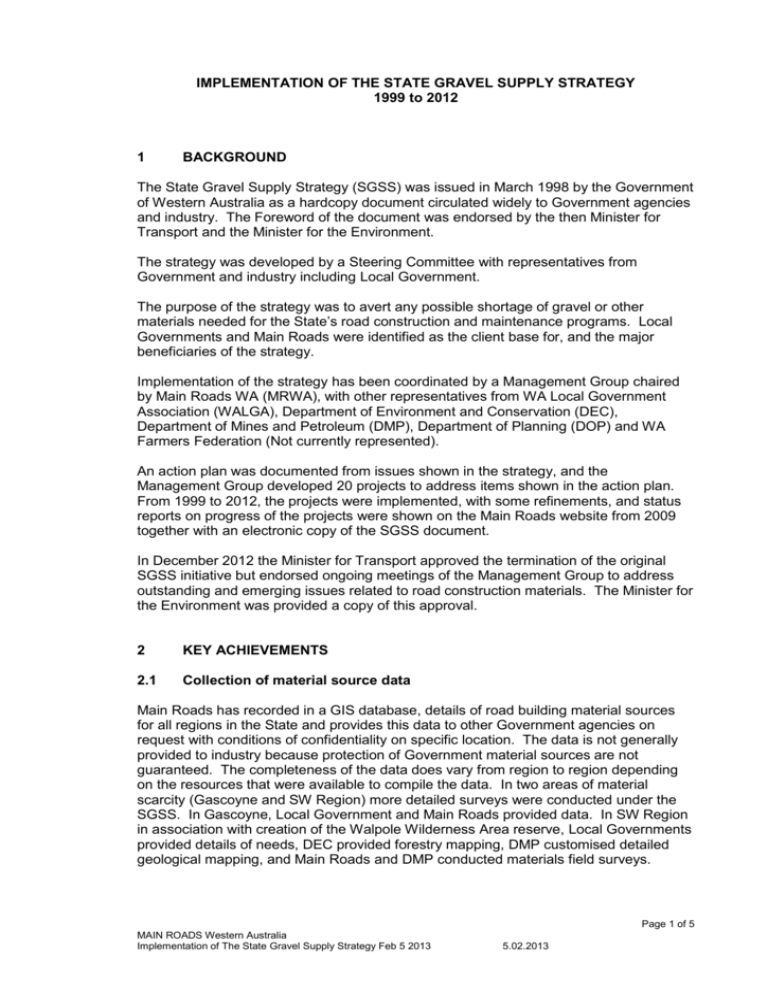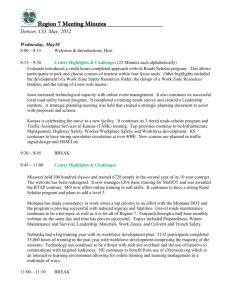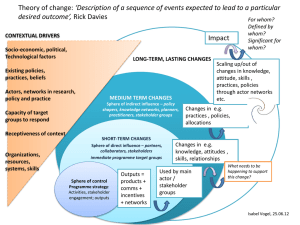IMPLEMENTATION OF THE STATE GRAVEL SUPPLY STRATEGY
advertisement

IMPLEMENTATION OF THE STATE GRAVEL SUPPLY STRATEGY 1999 to 2012 1 BACKGROUND The State Gravel Supply Strategy (SGSS) was issued in March 1998 by the Government of Western Australia as a hardcopy document circulated widely to Government agencies and industry. The Foreword of the document was endorsed by the then Minister for Transport and the Minister for the Environment. The strategy was developed by a Steering Committee with representatives from Government and industry including Local Government. The purpose of the strategy was to avert any possible shortage of gravel or other materials needed for the State’s road construction and maintenance programs. Local Governments and Main Roads were identified as the client base for, and the major beneficiaries of the strategy. Implementation of the strategy has been coordinated by a Management Group chaired by Main Roads WA (MRWA), with other representatives from WA Local Government Association (WALGA), Department of Environment and Conservation (DEC), Department of Mines and Petroleum (DMP), Department of Planning (DOP) and WA Farmers Federation (Not currently represented). An action plan was documented from issues shown in the strategy, and the Management Group developed 20 projects to address items shown in the action plan. From 1999 to 2012, the projects were implemented, with some refinements, and status reports on progress of the projects were shown on the Main Roads website from 2009 together with an electronic copy of the SGSS document. In December 2012 the Minister for Transport approved the termination of the original SGSS initiative but endorsed ongoing meetings of the Management Group to address outstanding and emerging issues related to road construction materials. The Minister for the Environment was provided a copy of this approval. 2 KEY ACHIEVEMENTS 2.1 Collection of material source data Main Roads has recorded in a GIS database, details of road building material sources for all regions in the State and provides this data to other Government agencies on request with conditions of confidentiality on specific location. The data is not generally provided to industry because protection of Government material sources are not guaranteed. The completeness of the data does vary from region to region depending on the resources that were available to compile the data. In two areas of material scarcity (Gascoyne and SW Region) more detailed surveys were conducted under the SGSS. In Gascoyne, Local Government and Main Roads provided data. In SW Region in association with creation of the Walpole Wilderness Area reserve, Local Governments provided details of needs, DEC provided forestry mapping, DMP customised detailed geological mapping, and Main Roads and DMP conducted materials field surveys. Page 1 of 5 MAIN ROADS Western Australia Implementation of The State Gravel Supply Strategy Feb 5 2013 5.02.2013 2.2 Estimate of material needs The 1998 State Gravel Supply Strategy estimated annual gravel supply needs of 5.4 million cubic metres for roadworks for Main Roads and Local Governments . Main Roads has calculated road building material needs of 5.5 million cubic metres per year for road improvement projects in the Roads 2025 Regional Roads Development Strategy and shows this data on its website. Roads 2025 covers State and local Government projects planned up to year 2025 but does not include maintenance needs or other roads such as private roads or DEC roads. Projects in Roads 2025 are dependant on funding. In 2000, DEC estimated total gravel needs for DEC and Forest Products Commission for years 2000 -2010 at 3.5 million cubic metres ie 0.35 million cubic metres per year which is still considered accurate. In 2012 DEC proposed a strategy to regravel 15% of its 5,580 km of strategic gravel roads over 10 years. This would require about 100,000 cubic metres of gravel per year. To regravel the full 5,580 km would require up to 7 million cubic metres in total. However even for the 15% strategy, the funding for this level of work is still uncertain. In 2001 WALGA provided estimates of Local Government needs of about 2.2 million cubic metres per year for resheeting gravel roads and 0.8 million for reconstructing sealed roads. These quantities were at the lower end of recommended practice and used by the Grants Commission in its Asset Preservation Model. The quantities shown above give an indication of the scale of the demand for roadbuilding materials, but to make use of the data for gravel supply purposes, an assessment within localised areas is needed where it can be matched to sources of material at economic cartage distances. This was investigated through the SGSS in areas where supply was known to be an issue (Gascoyne and SW Region). 2.3 Reservation of material sources The process to reserve key material resources has been followed to meet reservation requirements, and approval is pending from State Land Services, Department of Regional Development and Lands for 3 initial sites. This is providing a model for future reservations but has highlighted the long period of time required to achieve reservation and the need to also employ other mechanisms to protect sources. These other mechanisms can include measures under the Mining Act, Planning Acts, Land Administration Act and possible agreements with other agencies and Aboriginal Groups. 2.4 Amendment of the Local Government Act The Local Government Act was amended to improve access by Local Government to cleared agricultural land under pasture for grazing. By improving access to cleared land it provides an environmental benefit by reducing pressure to access uncleared land. 2.5 Payment of compensation to landowners Main Roads has initiated a written policy shown on its website for entry to private land and payment of compensation for damage resulting from removal of materials. This provides clarity to Main Roads staff as well as landowners. References to compensation under the Land Administration Act and the Local Government Act are included. Page 2 of 5 MAIN ROADS Western Australia Implementation of The State Gravel Supply Strategy Feb 5 2013 5.02.2013 2.6 Documented process to access materials from Crown Land The Management Group has documented processes for entry to Crown Land which is shown on the Main Roads website, and while it is focussed on entry by Main Roads, it is also a useful guide for other agencies including Local Government. Documentation of the processes involved considerable legal advice from the State Solicitors Office and this has greatly raised the awareness by the agencies represented on the Management Group of relevant legislation. In particular, the implementation of these processes, and the legal situation in relation to extraction of materials from mining areas and DEC managed land is now much better understood. 2.7 Environmental protection Protection of the environment in association with extraction of materials is now well established throughout Government and industry. The SGSS has contributed to this by assisting in the documentation of these processes. Documentation or improvement of processes has been done by Local Governments, Main Roads, DEC, DMP and DOP. A summary of the environmental approvals required at the planning stages of material extraction is shown in the procedure to enter Crown Land. 2.8 Establish a forum for communication between agencies The presence of the SGSS Management Group is a valuable forum to maintain communication and cooperation between agencies which are responsible for managing land or needing access to land to obtain materials. 3 OUTSTANDING WORK 3.1 Protect material sources This remains as a key uncompleted general objective. Mechanisms under existing legislation and policies have not fully achieved the needs of Main Roads or Local Governments. Although legislation does provide for Government to access materials from private and Crown land, this does not strategically protect resources. And because of the large number of existing sites, protection strategies need to be implemented in a short period of time to be effective. To date the most effective mechanism has been by policy agreements between agencies. Planning legislation was a mechanism in the SGSS objectives to protect material sources and this remains an option to be further investigated with DOP and Local Governments. In the meantime ongoing liaison with agencies in particular DEC, DMP and Aboriginal agencies is needed to protect material sources including creation of material reserves and protection from mining applications. In relation to mining, Main Roads would like to see an extension of the 2 year limit on Section 19 protection under the Mining Act. Some progress has been achieved, an example is an agreement with Aboriginal Groups in the Gascoyne Region to avoid detailed surveys and formal approvals at the reservation stage of land tenure change provided these surveys are completed prior to excavation planning. DOP has produced a Basic Raw Materials Applicants Manual to provide information on the approvals process in different land tenure situations. The document can be found on the Planning Website. Although the process is complex, the Manual provides improved Page 3 of 5 MAIN ROADS Western Australia Implementation of The State Gravel Supply Strategy Feb 5 2013 5.02.2013 clarity for applicants and approval agencies, and can provide a basis for future improvement and process streamlining. 3.2 Reserve key resources The reservation applications of material sources involving SGSS input have demonstrated the process of reservation and highlighted the related issues. It remains an option for critical sources but is not practical to protect large number of sites in the short term. However ongoing liaison with other agencies involved in the process is still recommended to streamline the process as much as possible. 3.3 Maintain databases of material sources The existing data needs to be updated to reflect new sources and depletion of current resources. Ideally data for all agencies should be covered, not necessarily in one database, but confirmation that strategic sources are documented is important so that agencies such as DMP and DOP can prepare accurate mapping and planning protection. 3.4 Continue to survey for materials sources in areas of scarcity This will continue regardless at a project level, but a longer term strategic level is still required as a basis for future supplies and protection. 4 REFOCUSSED OBJECTIVES Implementation of the SGSS was originally focussed on the needs of Main Roads and Local Governments as the principal public road construction agencies. However in recent years, the use of contractors and private industry partners to Government has blurred the boundaries of responsibilities for construction and maintenance. And the DEC public road system is now seeing increasing traffic and requires greater attention. Also, because of the increasing restrictions on access to land to obtain materials by environmental, aboriginal and competing mining interests, more strategic planning is now required to ensure materials can be accessible into the future. To cater for these changes, further work and collaboration is required between Main Roads, local governments, DOP, DMP, DEC, Aboriginal groups and Aboriginal related agencies. The initial focus of the strategy was naturally occurring road building materials needing minimum processing for use as road pavement materials. However as sources of these materials inevitably become more difficult to obtain, more processed materials such as crushed hard rock will need to be considered. In addition, materials for other uses, not just roads, could also be considered in the future. DMP and DOP are already working on a broader view of needs and sources in developing strategic mapping around major centres. This is beyond the scope of the original SGSS. 5 SGSS MANAGEMENT GROUP MEETINGS The Management Group will continue to meet as required but at least annually, to maintain communications between stakeholder agencies and to resolve issues related to road construction materials. SGSS Management Group February 5 2013 Page 4 of 5 MAIN ROADS Western Australia Implementation of The State Gravel Supply Strategy Feb 5 2013 5.02.2013 7 REFERENCES 7.1. State Gravel Supply Strategy 1998 7.2. SGSS Status Report 7.3. Roadbuilding Materials Needs for the Roads 2025 Regional Roads Development Strategy. 7.4. Operation Guideline 95 Sourcing Roadbuilding Materials from Freehold Land 7.5. Operational Guideline 96 Sourcing Roadbuilding Materials from State Crown Land Ref 7.1-7.5 Shown on the Main Roads website at: www.mainroads.wa.gov.au Building Roads/Standards and Technical/Materials Engineering/Pavements Technology 7.6. Environmental Guideline – Pits and Quarries Ref 7.6 shown on the Main Roads website at: www.mainroads.wa.gov.au Our Roads/Environment/Road Construction and Maintenance 7.7. Basic Raw Materials Applicants Manual Ref 7.7 shown on the Department of Planning website at: www.planning.wa.gov.au/publications 7.8. ROADS 2025 Ref 7.8 shown on the WALGA website at http://www.walga.asn.au/MemberResources/Infrastructure/AssetManagementandLocalR oadFunding/Roads2025RoadDevelopmentStrategy.aspx Page 5 of 5 MAIN ROADS Western Australia Implementation of The State Gravel Supply Strategy Feb 5 2013 5.02.2013




